by Editor | Jun 27, 2011 | Accomodations
By Elena del Valle
Photos by Gary Cox

The Peech Hotel
Since 2010 The Peech Hotel in Johannesburg, South Africa is a Fair Trade in Tourism SA certified property. Fair Trade in Tourism SA (FTTSA) is a non-profit organization that promotes sustainable tourism development. The certification means a third party has examined the hotel, its practices and its records closely and confirmed the property is committed to sustainability, and operating in a socially, economically and environmentally responsible manner. The concept is based on adherence to specific criteria for fair wages and working conditions, fair distribution of benefits, ethical business practices, and respect for human rights, culture and the environment.
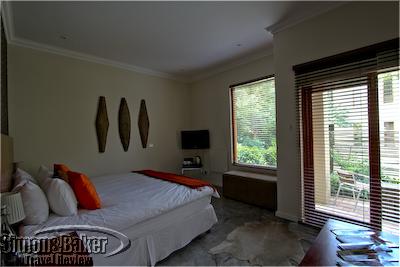
A room at The Peech with a view of the gardens
As part of its responsible tourism commitment The Peech supports Little Eden, a local nonprofit, with a guest donation program and monthly staff stays.
“Little Eden is very grateful for the continuous support received from The Peech Hotel,” said Nichollette Zulu who works in public relations at Little Eden, by email. “Over and above the regular monetary donations from The Peech Hotel, our Society is offered a night stay for two people meals included every month. We draw the list according to the birthday celebrations. This initiative has been running for over a year now.”
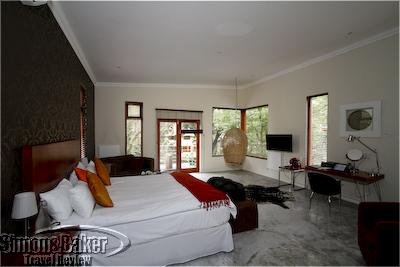
The Peech demonstrates that luxury can be green
Within the property The Peech focuses on four aspects: recycling, energy conservation, water conservation, and green design. To that end the hotel has an on-site probiotic waste facility that allows all food waste to be processed and recycled into garden fertilizer on site; has an on-site water bottling facility that provides drinking water for the restaurant and rooms, reducing plastic bottle waste; recycles as much non-biodegradable waste as is possible in South Africa including cans, paper, cardboard, glass and used kitchen oil; donates old furniture and linens to Little Eden; and keeps a compost heap to fertilize the flowerbeds.

James Peech
As part of its conservation efforts the hotel has solar water heating throughout the property including guest rooms, the kitchen and the laundry reducing electricity usage by a third; staff replace use timers and day-night sensors where possible to cut down use; maintains an electricity supply equal to that of a standard South African household; has installed gray water recycling in the Garden Suites which provides water for garden irrigation and reduces the use of chlorinated municipal water; has water efficient dual-flush toilets and water efficient landscaping; waters lawns only in early morning and late evening to minimize water evaporation; and uses ecological detergents and cleaning agents in the laundry and kitchen.

The hotel grounds include green space
Other green practices include hotel rooms with double-layer insulation to reduce heat in summer and heat-loss in winter. There are 92 square meters of green space per hotel guest to keep the hotel’s footprint to a minimum; the bistro grows some of its own herbs and vegetables keeping food deliveries down and the kitchen stocked with organic ingredients; and the hotel only uses rechargeable batteries. Kudos to The Peech!
Visit the Simon & Baker Travel Review for information about Johannesburg and our most recent stay at The Peech Hotel.
by Editor | Jun 20, 2011 | Luxury Travel
Article and photos by Laura Scheiber
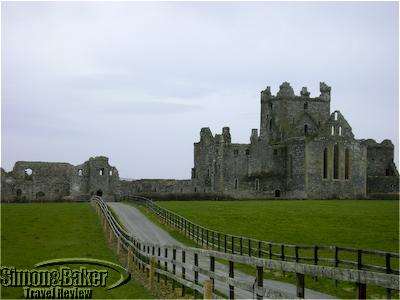
Driving along in the countryside in County Wexford
This was my third visit to Ireland, but the first time touring the South East of the Green Isle. After landing in Dublin on a sunny spring day, my travel partners and I spent the next six days exploring the many delights of County Wicklow, County Wexford, County Waterford, and County Kilkenny. Driving gave us the opportunity to take in the idyllic green countryside, impressive coastline, and fascinating medieval architecture.
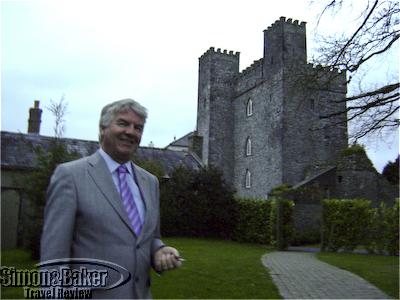
Ken Healy, proprietor, Barberstown Castle
Throughout the week we stayed in five different luxury accommodations: the Shelbourne Hotel Dublin, a landmark building in central Dublin (27 Saint Stephen’s Green, Dublin 2 Ireland, + 353 1 663 4500, www.theshelbourne.ie), The Ritz-Carlton Powerscourt, a well known countryside spa and resort (Powerscourt Estate, Enniskerry, Ireland, + 353 1 274 8888, http://www.ritzcarlton.com/en/Properties/Powerscourt/Default.htm, powerscourtreservations@ritzcarlton.com), Dunbrody Country House Hotel, a country Georgian manor situated in 300 acres of lush gardens (Arthurstown, County Wexford Ireland, +353 51 389 600, http://www.dunbrodyhouse.com/, info@dunbrodyhouse.com), the Cliff House Hotel, a seaside hotel (Ardmore, County Waterford, Ireland, + 353 24 87 800, http://www.thecliffhousehotel.com/, info@thecliffhousehotel.com), and Barberstown Castle which dated back to 1288 (Straffan, County Kildare, Ireland, +353 1 6288157, http://www.barberstowncastle.ie/).
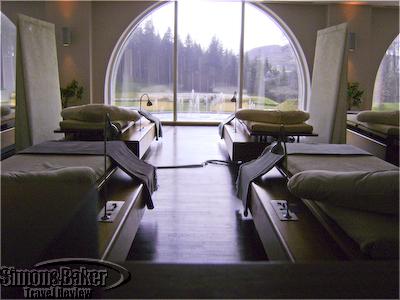
The Serenity Room at Espa at The Ritz-Carlton Powerscourt
I thoroughly enjoyed all of the accommodations and hope to return. One of the most memorable facilities was the spa at The Ritz-Carlton Powerscourt. Boasting 33,000 square feet in size, I especially enjoyed the pool that had 160 Swarovski crystals embedded in the bottom. The crystals reflected onto the ceiling to give the effect of a starlit evening. Situated in a low-lit room, I felt as if I was swimming in my own private pond on a summer’s evening. Simply divine.

Original bell from the Dunbrody Ship
On our third day, we visited the Dunbrody Famine Ship in New Ross, County Wexford (+353 51 425239, http://www.dunbrody.com/). The ship was a replica of the actual one that transported thousands of immigrants to North America in the 1800s during the Great Famine of Ireland. Our guide offered a fascinating travel back in time, and the interactive nature of the ship museum brought to life the daunting journey families embarked upon in their quest for a better life. Being one of the more than 35 million Americans who can trace their ancestry to Irish roots, I found the Dunbrody Famine Ship so captivating that it instigated a desire to learn more about my family’s Irish origins.

The Blowing Department at the Waterford Crystal Factory
The following day, we visited the new House of Waterford Crystal Factory (The Mall, Waterford City, Ireland, + 353 51 317000, http://www.waterfordvisitorcentre.com/). The 45 minute tour took us through the main working areas of the factory. I liked that the tour put us just feet away from the workers and we had the opportunity to interact with them. On that particular day, some of the sculptors were working on the People’s Choice Awards. While I am not a huge fan of crystal, I found the tour interesting and couldn’t resist purchasing a Waterford item available only in the showroom.
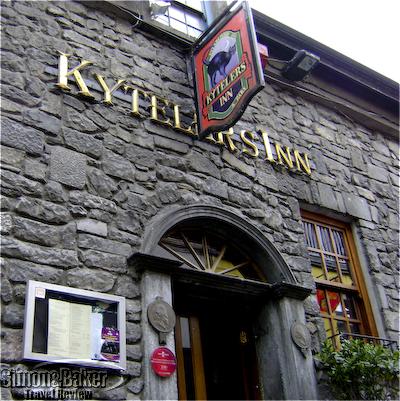
Outside of Kyteler’s Inn
My favorite cultural activity was a lesson on the traditional Irish bodhran drum at Kyteler’s Inn in Kilkenny (Kieran Street, Kilkenny, +353 56 772 1064, http://www.kytelersinn.ie/contact.asp). Our boisterous instructor, Helen McLoughlin (helenbodhran@hotmail.com), first demonstrated how to play the instrument and then sat us in a line of chairs with bodhrans in hand. She had us in stitches from her quick Irish wit, which helped ease our insecurities as we learned to play some basic rhythms. The interactive nature of the lesson which included singing traditional Irish folk songs lifted my spirits.
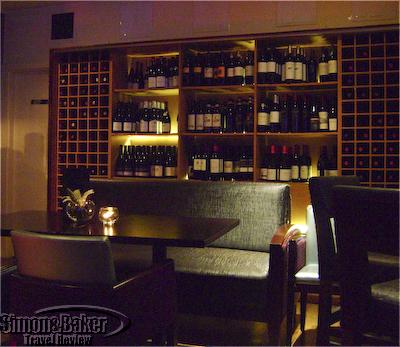
Downstairs bar at L’Escrivain
I was pleasantly surprised to enjoy five nights of outstanding gastronomy. In all of the restaurants, the executive chefs used fresh local produce and locally sourced seafood. My travel partners and I compared our favorite dishes. A professional foodie said that her main dish (Breckland duck with butternut squash and pine nut dressing) at L’Escrivain Restaurant (109a Lower Baggot Street, Dublin 2, + 353 1 6611919, http://www.lecrivain.com/, enquiries@lecrivain.com) was the best duck she had ever eaten.
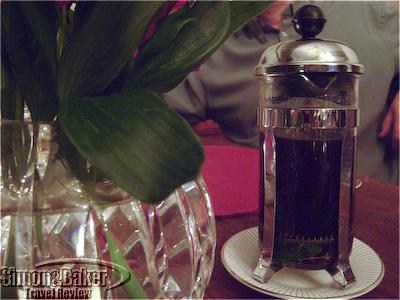
Beef tea at the Cliff House Hotel Restaurant
My favorite restaurant in terms of artistic food presentation and exquisite hospitality was The House restaurant at the Cliff House Hotel. We enjoyed a number of innovations by Executive Chef Martin Kajuiter such as “beef tea,” a beef broth for the Black Angus beef, which was delivered in a tea press teapot. I enjoyed the Helvick cod with spinach and Dingle Bay Crab carefully wrapped in a special package to seal in the flavors.
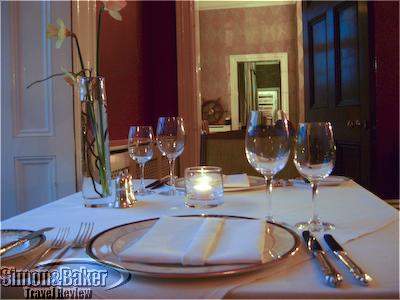
Dining table at The Harvest Room Restaurant
At Barberstown Castle, my six-course meal included scrumptious panned fried scallops and halibut in a citrus butter sauce. We dined in the oldest section of the medieval castle, and it felt as if I had been magically transferred back to the 1300s. The Harvest Room Restaurant at Dunbrody Country House Hotel offered a charming romantic country setting, and I will never forget that heavenly chocolate lava cake and divine Chateau Bel Air Perpencher, a Bordeaux red wine. The service in the restaurants was friendly and attentive without being overbearing.
All in all, my travels in South East Ireland were unforgettable. I would recommend the region to any of my family and friends who are captivated by Celtic history and culture, interested in finding out more about their Irish ancestry, or for those who enjoy the delights of gourmet Irish cuisine.
by Editor | Jun 13, 2011 | Accomodations, Food
Article and photos by Elena del Valle
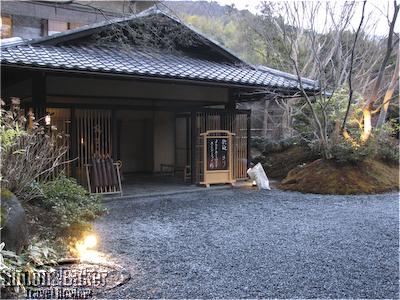
Entrance to the Ryokan Yagyu-No-Sho
Earlier this year when I was in Japan I visited Izu, an area of the country known for its hot springs. The highlight of my stay was spending the night in a luxury ryokan, a traditional Japanese hotel. My brief visit was especially rewarding and memorable for the experience itself as well as the many luxury features the ryokan offered. While the property catered mostly to Japanese customers it was part of a national alliance of luxury ryokans that facilitated bookings by international travelers.
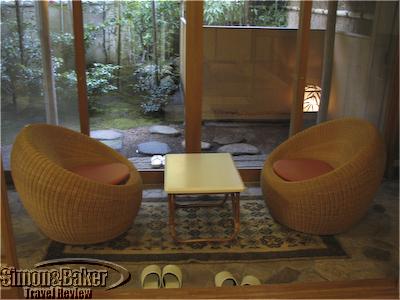
Looking out at my corner garden
In spite of steep linguistic challenges I felt welcome and would be pleased to return for a longer stay. Some of the characteristics of the ryokan I enjoyed the most were the traditional style of the facilities with flower arrangements (made by one of the owners) and artwork, manicured gardens with water features, friendly and service oriented staff, hot spring related offerings and delicious gourmet meals. There was excellent and fast complimentary WiFi connectivity in my suite, an amenity I greatly appreciated.
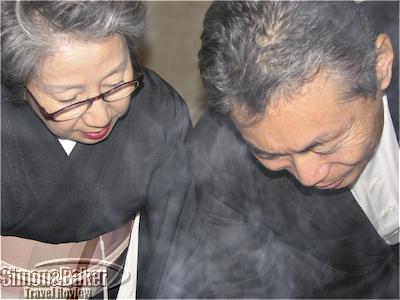
The ryokan owners preparing a meal
Yagyu-No-Sho, a traditional style ryokan with modern conveniences in the heart of a village, was owned and managed by Takashi Hasegawa and his wife. In the entrance foyer, my eyes were drawn to the wall wide bamboo forest with small birds, a beautiful artwork made of wood panels painted by a Japanese artist in her 90s who is well liked by the imperial family. In her painting, one of the staff explained, she uses only natural materials. The green in the painting was from oxidized copper and the white was from a stone.
On arriving at the ryokan we were invited to remove our shoes and wear a pair of house slippers (this was rather uncomfortable because the slippers they provided were several sizes larger than my feet and made it necessary for me to walk slowly to avoid tripping). I shed my slippers to enter my room which was covered wall to wall with tatami mats.

Artwork on wood panels with natural materials
My second floor room, Harvest, had a private bathroom with a separate section that housed a wood tub filled with hot springs water. The room, divided into several areas by thin paper and wood walls, was pretty and spacious. The décor was in a traditional Japanese style furnished with simple floor level chairs and tables. Instead of a bed the staff set up a sleeping area, at the end of the day, with futons, duvet blankets and feather pillows that were kept in a closet during the day. I slept very well in the comfortable floor level futon. There was a small indoor patio with Western style chairs and a table next to the room where my sleeping area was set up. Next to the patio there was an outdoor area that could be reached, while wearing special outdoor slippers, via sliding glass doors.
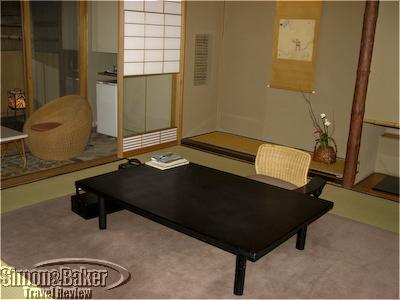
Ryokan room with traditional furnishings
The room had a living area with a low table and one cushioned armless low chair. A recessed area was home to a flower arrangement. There was also a sitting area with a low table and two chairs. Under the table there was space to rest my feet on the warm floor. To one side stood a small vanity with a mirror, tissue paper, and a cushion.
The bathroom was divided into three separate rooms. One housed a water closet with an automated Japanese heated toilet and and a mini wood sink. There was a wide room with a sink; next to it was the bath tub room which had just enough space for a large wood bath tub and a small shower area placed against the wall. The shower corner, low to the ground, consisted of a small wood stool and a handheld hose to shower thoroughly before dipping in the hot water of the tub.

Ryokan staff in traditional dress
The temperature within the room was comfortable for me. It was controlled with a remote control. Amenities, set inside a cloth bag on the tatami floor, were: a set of Japanese pajamas, shower cap, toothbrush, hairbrush, cotton pad, cotton swabs, and hair scrunchy. There was a mini refrigerator next to the coat closet.
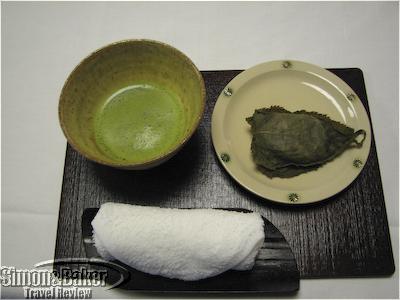
Excellent green tea
Dinner, served at 6 p.m. sharp consisted of 12 generous courses of Japanese dishes. Although it would usually have been served in individual rooms, the ryokan staff set up group seating for the six of us in one of their large rooms. To keep our hands clean we were provided with three wet towels during the course of the meal. The service began with a taste of unfermented sake as an aperitif. Meals, clearly, were an important part of the experience at this ryokan. There was a pretty dinnerware service with different dishes for the varied courses. Three ladies looked after us and served us copious quantities of delicious food.

The food was attractively served and delicious
Breakfast the next morning was equally well served and as satisfying. We had rice; pickled vegetables; miso soup; beef, shiitake mushrooms and long onion cooked with a large leaf over charcoal; boiled sliced beef with a sweet soy sauce; tuna and long onion with vinegar miso; salted and fermented squid innards; deep fried tofu burger; dried fish; egg custard; sweet red bean soup with rice cake; and sherbert.
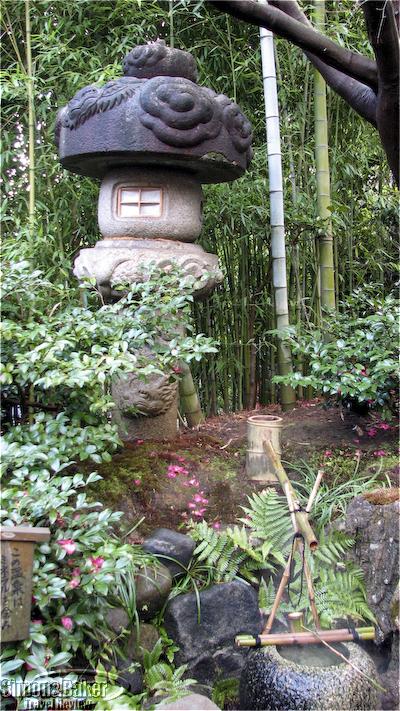
Tranquil gardens
If the opportunity presents itself I would gladly return to Yagyu-No-Sho. Next time I would request one of the ryokan’s ground floor luxury suites with indoor water features where some of my travel companions stayed. Yagyu-No-Sho, 1116-6, Shuzenji, Izu-City, Shizuoka-Prefecture, Japan, +81558724126, Fax +81558725212, http://www.yagyu-no-sho.com
by Editor | Jun 6, 2011 | Accomodations, New Articles
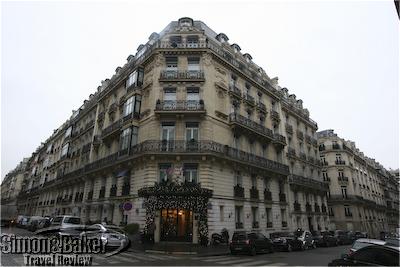
Hotel de La Trémoille
Hotel de La Trémoille, a small hotel minutes away from the Champs Elysees in Paris, France offered a good option for accommodations. The multistory hotel on a quiet street offered comfort and luxury accommodations with modern touches and friendly service. Our team’s junior suite was comfortable and warm in winter with a view, from the balcony, of the famous Eiffel Tower and excellent internet connectivity.
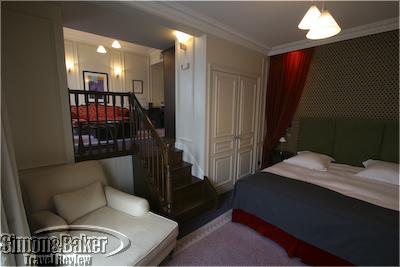
The junior suite was on two levels
Visit the Simon & Baker Travel Review for additional information on Paris and the Hotel de la Tremoille.
































